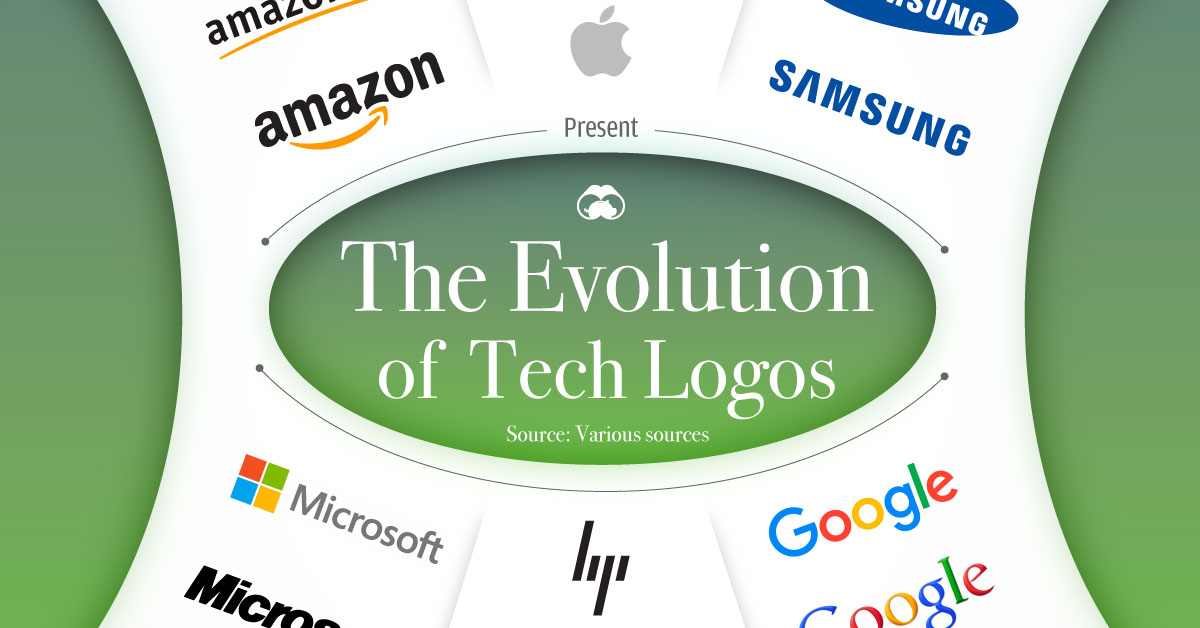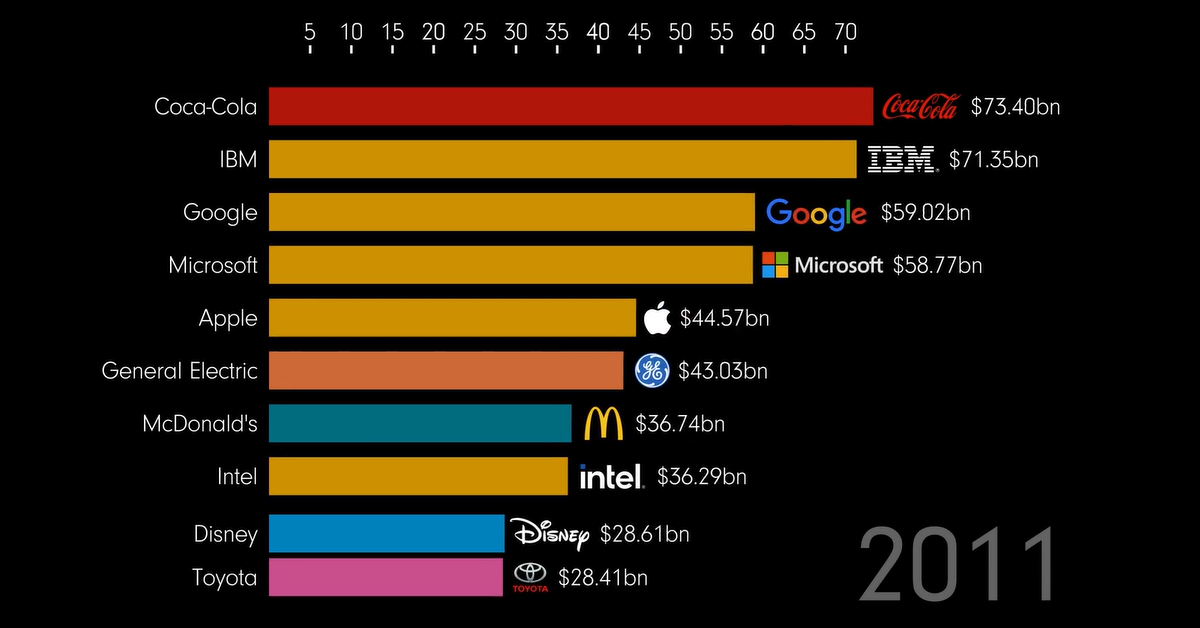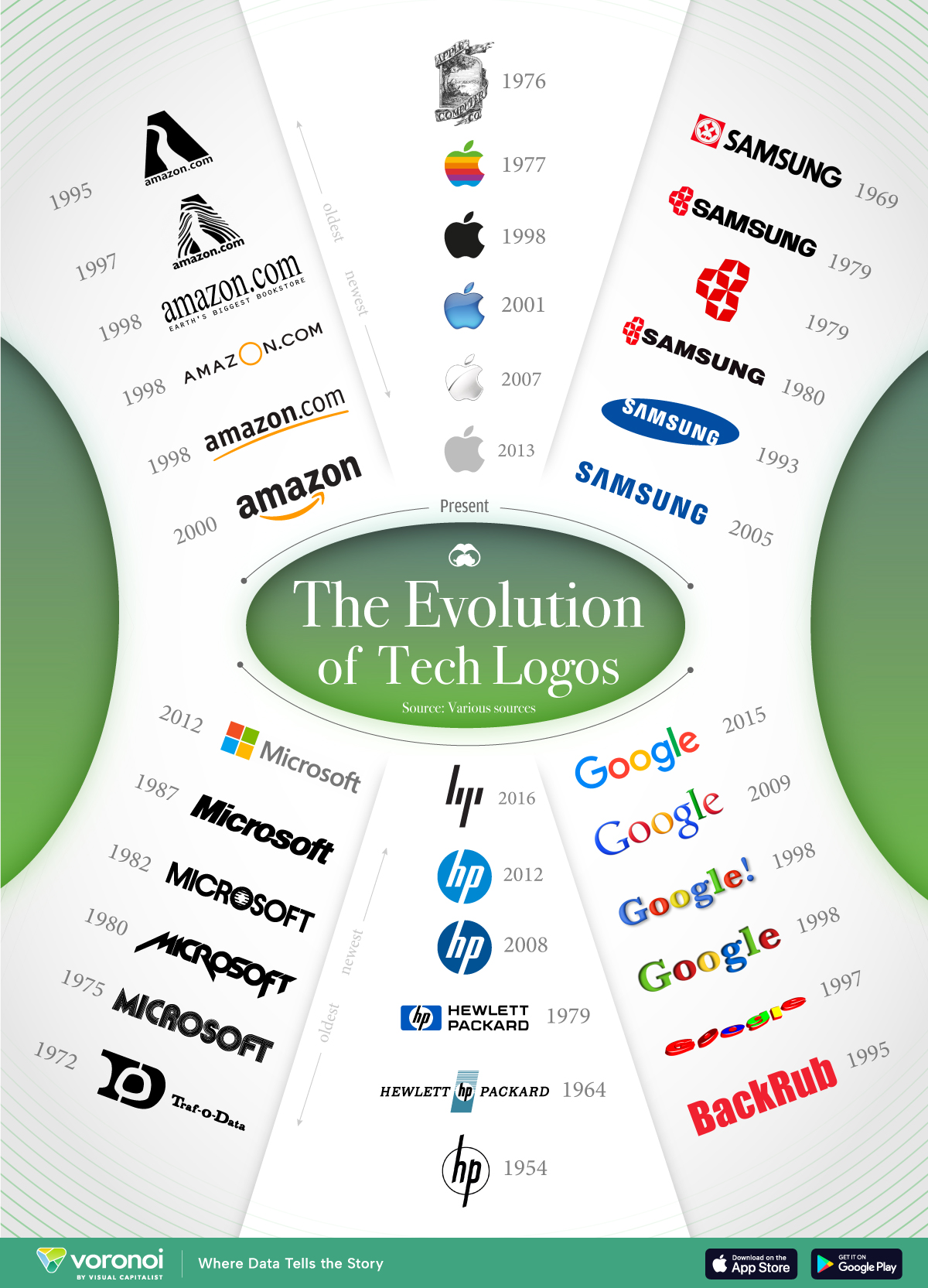Brands
Animated: The Most Valuable Brands From 2000–2022
The Most Valuable Brands From 2000–2022
How much money is a brand truly worth?
For some companies, a brand is something that helps slightly boost customer engagement and sales. But for others, including some of the largest companies in the world, a strong brand is one of their most valuable assets.
This animated graphic by James Eagle uses the annual brand rankings from Interbrand to track the world’s most valuable brands from 2000 to 2022.
Measuring Brand Value
One of the difficulties of brand valuation is its subjectivity.
In accounting, the value of a brand is sometimes represented as an intangible asset called goodwill on the balance sheet. That’s because the brand power associated with a company (i.e. brand recognition, brand loyalty, customer base, reputation, etc.) often makes a company more valuable than just the sum of its tangible assets like land, buildings, or product inventory.
This works for accounting purposes but is still a rough estimation, and doesn’t precisely quantify a brand’s true value.
For Interbrand’s studies, a consistent formula for brand strength was utilized which is based on a company’s financial forecast, brand role, and brand strength. It uses estimates of the present value of earnings a brand is forecasted to generate in the future.
The Top 10 Most Valuable Brands Since 2000
When the 2000s started, the internet was top-of-mind in terms of both markets and customer perception. The Dotcom bubble was driving the world’s largest companies, and brand value at the time reflected tech’s popularity:
| Rank | Brand | Value (2000) | Industry |
|---|---|---|---|
| 1 | Coca-Cola | $72.5B | Beverages |
| 2 | Microsoft | $70.2B | Tech |
| 3 | IBM | $53.2B | Tech |
| 4 | Intel | $39.1B | Tech |
| 5 | Nokia | $38.5B | Tech |
| 6 | General Electric | $38.1B | Energy |
| 7 | Ford | $36.4B | Automotive |
| 8 | Disney | $33.6B | Media |
| 9 | McDonald's | $27.9B | Restaurants |
| 10 | AT&T | $25.6B | Telecom |
Half of the top 10 most valuable brands at the time were in tech or telecom, including Microsoft, IBM, and Nokia.
Others were classic American brands and companies at the top of their fields, including Coca-Cola, General Electric, Ford, and McDonald’s.
But over the next 20 years, much of the old guard was replaced by new and rising brands. By 2022, only three of the top 10 most valuable brands from 2000 remained at the top:
| Rank | Brand | Value (2022) | Industry |
|---|---|---|---|
| 1 | Apple | $482.2B | Tech |
| 2 | Microsoft | $278.3B | Tech |
| 3 | Amazon | $274.8B | Consumer |
| 4 | $251.8B | Tech | |
| 5 | Samsung | $87.7B | Tech |
| 6 | Toyota | $59.8B | Automotive |
| 7 | Coca-Cola | $57.5B | Beverages |
| 8 | Mercedes-Benz | $56.1B | Automotive |
| 9 | Disney | $50.3B | Media |
| 10 | Nike | $50.3B | Consumer |
Apple’s brand is now worth an estimated $482 billion, even though the company didn’t even crack the top 10 list back in the year 2000.
In fact, four of the top five brands on the 2022 list are directly in tech, and even Amazon (#3) is often considered a tech giant. Not surprisingly, brand value in the top 10 has grown almost across the board, though Coca-Cola is a notable exception, dropping $15 billion in estimated brand value over 22 years.
How will the most valuable brands continue to evolve over the coming decades?

This article was published as a part of Visual Capitalist's Creator Program, which features data-driven visuals from some of our favorite Creators around the world.
Brands
How Tech Logos Have Evolved Over Time
From complete overhauls to more subtle tweaks, these tech logos have had quite a journey. Featuring: Google, Apple, and more.

How Tech Logos Have Evolved Over Time
This was originally posted on our Voronoi app. Download the app for free on iOS or Android and discover incredible data-driven charts from a variety of trusted sources.
One would be hard-pressed to find a company that has never changed its logo. Granted, some brands—like Rolex, IBM, and Coca-Cola—tend to just have more minimalistic updates. But other companies undergo an entire identity change, thus necessitating a full overhaul.
In this graphic, we visualized the evolution of prominent tech companies’ logos over time. All of these brands ranked highly in a Q1 2024 YouGov study of America’s most famous tech brands. The logo changes are sourced from 1000logos.net.
How Many Times Has Google Changed Its Logo?
Google and Facebook share a 98% fame rating according to YouGov. But while Facebook’s rise was captured in The Social Network (2010), Google’s history tends to be a little less lionized in popular culture.
For example, Google was initially called “Backrub” because it analyzed “back links” to understand how important a website was. Since its founding, Google has undergone eight logo changes, finally settling on its current one in 2015.
| Company | Number of Logo Changes |
|---|---|
| 8 | |
| HP | 8 |
| Amazon | 6 |
| Microsoft | 6 |
| Samsung | 6 |
| Apple | 5* |
Note: *Includes color changes. Source: 1000Logos.net
Another fun origin story is Microsoft, which started off as Traf-O-Data, a traffic counter reading company that generated reports for traffic engineers. By 1975, the company was renamed. But it wasn’t until 2012 that Microsoft put the iconic Windows logo—still the most popular desktop operating system—alongside its name.
And then there’s Samsung, which started as a grocery trading store in 1938. Its pivot to electronics started in the 1970s with black and white television sets. For 55 years, the company kept some form of stars from its first logo, until 1993, when the iconic encircled blue Samsung logo debuted.
Finally, Apple’s first logo in 1976 featured Isaac Newton reading under a tree—moments before an apple fell on his head. Two years later, the iconic bitten apple logo would be designed at Steve Jobs’ behest, and it would take another two decades for it to go monochrome.
-

 Green1 week ago
Green1 week agoRanked: The Countries With the Most Air Pollution in 2023
-

 Automotive2 weeks ago
Automotive2 weeks agoAlmost Every EV Stock is Down After Q1 2024
-

 AI2 weeks ago
AI2 weeks agoThe Stock Performance of U.S. Chipmakers So Far in 2024
-

 Markets2 weeks ago
Markets2 weeks agoCharted: Big Four Market Share by S&P 500 Audits
-

 Real Estate2 weeks ago
Real Estate2 weeks agoRanked: The Most Valuable Housing Markets in America
-

 Money2 weeks ago
Money2 weeks agoWhich States Have the Highest Minimum Wage in America?
-

 AI2 weeks ago
AI2 weeks agoRanked: Semiconductor Companies by Industry Revenue Share
-

 Travel2 weeks ago
Travel2 weeks agoRanked: The World’s Top Flight Routes, by Revenue











